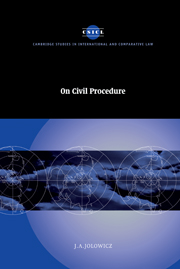Book contents
- Frontmatter
- Contents
- Preface
- List of abbreviations
- Introduction
- I The litigation process
- II Protection of diffuse, fragmented and collective interests
- III Procedural modes
- 8 Civil and administrative procedure
- 9 Adversarial and inquisitorial approaches to civil litigation
- IV The parties and the judge
- V Recourse against judgments
- VI Procedural reform
- Index
- CAMBRIDGE STUIDES IN INTERNATIONAL AND COMPARATIVE LAW
8 - Civil and administrative procedure
from III - Procedural modes
Published online by Cambridge University Press: 18 December 2009
- Frontmatter
- Contents
- Preface
- List of abbreviations
- Introduction
- I The litigation process
- II Protection of diffuse, fragmented and collective interests
- III Procedural modes
- 8 Civil and administrative procedure
- 9 Adversarial and inquisitorial approaches to civil litigation
- IV The parties and the judge
- V Recourse against judgments
- VI Procedural reform
- Index
- CAMBRIDGE STUIDES IN INTERNATIONAL AND COMPARATIVE LAW
Summary
A single jurisdiction: a divided procedure
The civil procedure introduced into the unified Supreme Court as a result of the nineteenth-century reforms, whose principal characteristics have survived for so long, allowed for two principal modes for the conduct of civil litigation. In the procedure by writ, written pleadings and the disclosure of relevant documents were required, and the evidence - generally oral evidence - was given at the trial. In the procedure by originating summons, on the other hand, formal pleadings were not required, a judicial order was necessary if discovery was to be made, and the evidence was mainly given in written form by affidavit. Originating summons procedure was not to be used where serious issues of fact between the parties were anticipated, but where it emerged that the choice of this procedure had been wrongly made, the proceedings could simply be ordered to be continued as if begun by writ. There was no impenetrable barrier between the two modes. Each was a variant of a single procedure - ‘procedure by action’ or simply ‘action’.
Under the C.P.R., there is only one form of originating process - the ‘claim form’ - and the older terminology has been abandoned, but the distinction between the two modes of procedure is preserved. What is now known as ‘Part 8 procedure’ is broadly equivalent to the originating summons.
- Type
- Chapter
- Information
- On Civil Procedure , pp. 151 - 174Publisher: Cambridge University PressPrint publication year: 2000
- 1
- Cited by



